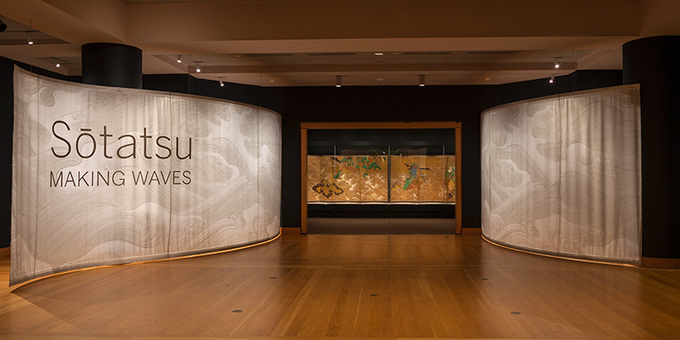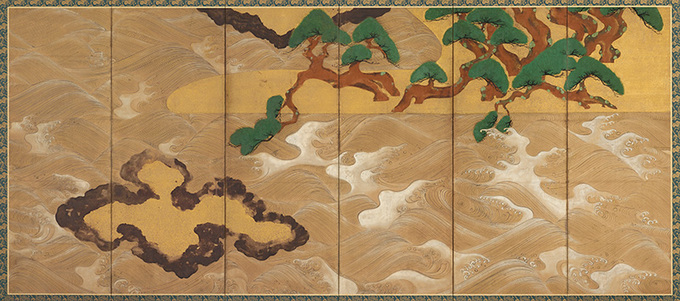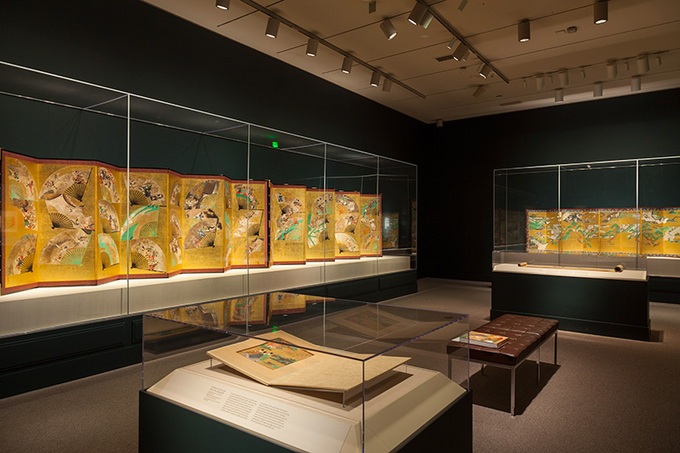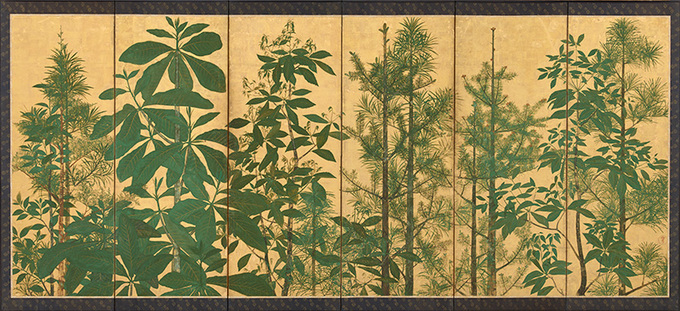Sōtatsu Makes Waves in Washington, D.C.
James T. Ulak
Senior Curator of Japanese Art
Freer Gallery of Art and Arthur M. Sackler Gallery
Smithsonian Institution
The Japan Foundation, in partnership with the Freer Gallery of Art and Arthur M. Sackler Gallery (Washington, D.C.), presented the exhibition Sōtatsu: Making Waves (October 24, 2015-January 31, 2016) at the Sackler Gallery. Co-curator James Ulak contributed some observations and insights about the exhibition highlights and audience reactions to works by an artist not well-known to Western audiences.

The entrance to Sōtatsu: Making Waves exhibition offers the viewer the immediate impact of the artist's Waves at Matsushima screens, created in the late 1620s and deposited in Shōun-ji Temple, Sakai City.
On October 24, 2015, the American art viewing public added the somewhat unfamiliar name of Sōtatsu to a growing list of individual Japanese artists given prominence in focused exhibitions at major United States museums during the past several decades.
As of this writing (mid-December 2015), seven weeks into the exhibition Sōtatsu: Making Waves (Arthur M. Sackler Gallery, Washington, D.C.), we can safely say that "the most important artist you have never heard of" has touched an eager audience and his name is scattered locally, nationally, and internationally across newspaper reviews, advertisements, web broadcasts, and billboards. More than 50,000 visitors have already seen Sōtatsu: Making Waves, a number that will significantly increase by the end of January 2016. The demand for the exhibition catalogue, attendance at lectures and symposia suggests a strong appetite for deep background. Clearly, Sōtatsu's nearly acquired U.S. fan base want not only beauty but background. Wave imagery and the name Sōtatsu are completely linked to and embedded in the cultural fabric of this capital city about to enter the winter holiday season.
The exhibition title derives from what might be described as the crowning achievement of Sōtatsu's painterly skills, a pair of screens featuring pine-studded rocky island-like outcroppings placed amidst dramatically and gorgeously stylized waves. Acquired by the U.S. industrialist and art collector Charles Lang Freer (1854-1919) in 1906, these paintings soon took on the English title of Waves at Matsushima (although current scholarship discounts these paintings as describing an actual geographic setting). From the time of their creation in the late 1620s, commissioned as a gift for the Rinzai Zen temple of Shōun-ji in the port city of Sakai on Japan's Inland Sea, the screens were closely held until the first years of the 20th century when they were purchased from the temple by the art dealer Kobayashi Bunshichi (1861-1923) and sold to Freer. In 1905, Freer had acquired another pair of Sōtatsu screens painted in shades of ink and featuring dragons swirling in clouds. Freer's passion for the works of Sōtatsu was fed by another and earlier interest in the works of Hon'ami Kōetsu (1558-1637) a distinguished calligrapher, potter and Sōtatsu's mentor and collaborator in the first two decades of the 17th century. Indeed, with the dual anchors provided by these magnificent Freer paintings, the leitmotif of waves and the life-creating power of water reverberates through the exhibition.

Tawaraya Sōtatsu (act.ca. 1600-40) Waves at Matsushima c.1627 detail from a pair of six-panel folding screens. Freer Gallery of Art F1906.231-232
More than five years ago representatives of the Japan Foundation approached the Freer Gallery of Art and the Arthur M. Sackler Gallery of the Smithsonian Institution with a proposal to partner in a general exhibition on the topic of Rinpa style painting. Specialists in the field of Japanese art understood two important facts: 1) the collection of Rinpa style painting assembled by Charles Lang Freer was first-rate; and 2) a condition(*1) of Freer's will prohibited the borrowing and lending of works of art. This strict clause was slightly ameliorated with the opening of the adjoining and jointly administered Arthur M.Sackler Gallery (1987) by providing a special exhibition space in which, on occasions of historic merit, works from the Freer can be comingled with works from outside collections. These conditions set the stage for a major exhibition of Rinpa art, but as conversations progressed, all parties agreed that the opportunity to focus on the centrality of Freer's paintings to the Sōtatsu canon suggested an exhibition which could to shed new light on Sōtatsu, a Sōtatsu unencumbered by the attempts of later generations to place him at the head of a stylistic school.
The exhibition at the Arthur M. Sackler Gallery presents Tawaraya Sōtatsu as an artisan, a conservator of important paintings and documents, a craftsman adept at creating finally decorated papers and backgrounds for the works of outstanding calligraphers and as the proprietor of a fan shop located on Gojō-dōri in Kyoto in the several decades on either side of 1600.
After an initial presentation of the Waves at Matsushima screens, the exhibition presents an evolving Sōtatsu: as a collaborator with his mentor Hon'ami Kōetsu (1558-1637); as a painter and craftsman curious and adept channeling approaches and sources from China and Korea into his evolving repertoire; and as a person who, in a particularly fluid moment in Kyoto's history, achieves access to the highest levels of the aristocracy thus finding both partners and patrons.
Successive galleries display in detail his wonderful jazz-like riffs, playing bold or subtle backup to Kōetsu's calligraphy; Sōtatsu displaying his particular penchant for deconstructing well-known stories told in handscroll formats created in the Heian and Kamakura periods and producing fragment images or quotations of those stories on the surfaces of folding fans and jewel-like album leaves, energizing and liberating the images from the particulars of individual ownership and from linear narrative, and contributing to the wider early Edo period phenomenon of a growing recognition of literary classics not by texts but by a new canon of visual clues. Sōtatsu the ink painter is displayed in a gallery which features the painter's approaches to traditional Buddhist subjects, court subjects and scenes of everyday life. His masterful use of the pooled ink technique of tarashikomi is highlighted.

View of "Classics" gallery in Sōtatsu: Making Waves. Sōtatsu and his studio created new and vigorous imagery of such classical texts as The Tales of Ise and The Tale of Genji. The folding fan became a central instrument of image dissemination.
Although Sōtatsu's dates of birth and death are unknown, it is generally assumed that around 1640 he had ceased activity and his Tawaraya studio continued, probably under the leadership of Sōsetsu. At this stage the use of the seal reading "I'nen" becomes prominent and the profusion of paintings featuring flowering plants and trees becomes virtually synonymous with the Tawaraya and its remnants for another fifty or more years. A gallery displaying lavish paintings of plants and flowers--many exotic--shows a new tendency toward an encyclopedic precision of representation. With this the painters of the post-Sōtatsu studio reveal a broader sense of a changing Japanese view of the natural world, moving from purely metaphorical perceptions to a more detached and scientific approach.
A gallery concluding the Edo period portion of the exhibition narrative shows in a profusion of fine examples the persistence of wave imagery with works by Ogata Kōrin (1658-1716 ), Sakai Hōitsu (1761-1828), Suzuki Kiitsu (1796-1858), and other anonymous painters. Sōtatsu, although overshadowed by later interpreters, continues his influence with this powerful image of waves and finally, in the early 20th century, experiences a resurrection of sorts. With his paintings featured in a 1913 exhibition in Tokyo, Sōtatsu becomes known to a new generation of Japanese painters seeking a modern voice in ancient sources. The influence of that 1913 exhibition is displayed in the final gallery of Sōtatsu: Making Waves with representative works of 20th century Japanese painters who clearly declared the influence of Sōtatsu on their imaginations.

Left: View of "Legacy of Waves" gallery in Sōtatsu: Making Waves. Imagery inspired by Sōtatsu's Waves at Matsushima screens was produced after his death. Works attributed to Ogata Kōrin are most notable in that lineage.
Right: View of the "Rediscovery" gallery in Sōtatsu: Making Waves. The 1913 Sōtatsu exhibition in Tokyo inspired many important Japanese painters to adapt compositional, technical and thematic techniques from Sōtatsu and later Rinpa painters.

Sōtatsu school, mid-1600s, Trees, detail from pair of six-panel folding screens, Sōtatsu school, Freer Gallery of Art F1962.30-31.
Featuring more than seventy works from twenty-eight lenders in Japan, Europe and the United States, Sōtatsu: Making Waves has set a new standard of Japan-U.S. scholarly collaboration, all thanks to the initiative of the Japan Foundation.
*1: In 1906 Charles Lang Freer donated his art collection and financial support to build and sustain a museum to the United States government through the structure of the Smithsonian Institution. A condition of Freer's gift as stated in his will was that no works in the collection may be loaned outside the museum nor may works from outside the collection be borrowed and displayed in the museum.
All photos of the exhibition are provided by Freer|Sackler
 James T. Ulak
James T. Ulak
James T. Ulak, PhD, is Senior Curator of Japanese Art for the Freer Gallery of Art and the Arthur M. Sackler Gallery of the Smithsonian Institution and has been at the Freer Gallery of Art and Arthur M. Sackler Gallery since 1995. He has previously held research and curatorial posts at The Cleveland Museum of Art, Yale University Art Gallery, and the Art Institute of Chicago. He has published on a wide range of topics in Japanese art and has organized numerous exhibitions. He is the co-curator (with Ryō Furuta, Associate Professor at Tokyo University of the Arts) of Sōtatsu: Making Waves. In 2010 he was awarded the Order of the Rising Sun in recognition of his efforts to strengthen Japan-United States cultural ties.
Keywords
- Cultural Heritage
- Arts/Contemporary Arts
- Japan
- United States
- Washington D.C.
- Smithsonian Institution
- Freer Gallery of Art
- Arthur M. Sackler Gallery
- Edo Period
- Tawaraya Sōtatsu
- Charles Lang Freer
- Shōun-ji Rinzai Zen Temple
- Kobayashi Bunshichi
- Hon'ami Kōetsu
- Rinpa style
- Ogata Kōrin
- Sakai Hōitsu
- Suzuki Kiitsu
- Japan Art Association
Back Issues
- 2025.7.31 HERALBONY's Bold Mis…
- 2024.10.25 From Study Abroad in…
- 2024.5. 2 People-to-People Exc…
- 2022.11. 1 Inner Diversity<3> <…
- 2022.9. 5 Report on the India-…
- 2022.6.24 The 48th Japan Found…
- 2022.6. 7 Beyond Disasters - …
- 2021.3.10 Crossing Borders, En…
- 2020.7.17 A Millennium of Japa…
- 2020.3.23 A Historian Interpre…

